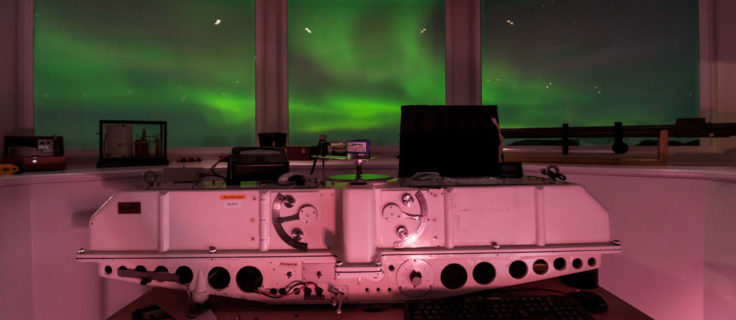5 February, 2016 Halley
“I feel like I’m home” says BBC weather forecaster Peter Gibbs as he sets foot on the Brunt Ice Shelf. It’s an emotional moment for him; the last time he was here was 1981 and the station he lived two years at was very, very different.

Since arriving we’ve been busy. Once the ship was safely tied up against the ice edge we had a four-hour journey to Halley in a Snocat – a kind of ice tractor. We trundled along at 10 miles an hour across a vast, bumpy expanse of ice. It was cramped and uncomfortable, yet thrilling and surreal at the same time.
So, here I am in Antarctica, the coldest desert in the world, and as we cross the horizon, this tiny line of modular buildings comes into view, like a misplaced alien space ship. The buildings are royal blue and red; our first glimpse of colour after miles of white.
For the first few hours after arriving I feel like I’m on a new planet. I knew I was there, but my mind couldn’t quite comprehend and process it. It’s just so different. We had an induction from the station leader Adam and I felt completely dazed. Peter quickly felt very much at home, but the rest of the crew, like me, hadn’t quite caught up. One minute we’re living on a ship and the next minute…this.

Halley is a site occupying approximately two square kilometres. The epicentre is made up of the new building with eight red and blue modules containing everything needed for the wintering team of 12. There’s the red A module, which contains the communal areas including a large and airy dining room, a lounge with big homely sofas and a TV room upstairs used for talks and cinema nights. Further along in the adjoining blue modules there are offices, generators, lots of humming machinery, two-person bedrooms, a surgery, labs and workshops and, lastly, a cosy library which acts as a ‘quiet room’.
What I love so much is how the huge windows allow so much light to flood inside. Right now it’s 24 hours of sunshine. In winter it may be dark, but the team enjoys spectacular views of the Aurora Australis otherwise known as the southern lights. So the giant triangular windows let the outside in.

Another thing that has struck me is how friendly everyone is and just how much they love being at Halley. On my second day I spoke to Station Assistant Richard who has just over-wintered at Halley. He was describing his time and how special it has been. I asked if he’d like to winter at another station like Rothera, his reply was “my heart is at Halley.” Others are also clearly smitten with this place, and I can totally understand why. It is awesome, surreal and totally has the WOW factor. Mechanical services technician Tom, who leaves the station tomorrow after 16 months here, announces it’s his last day when we’re all together having an update from the station leader. He says he feels really emotional. I can understand why – he’s leaving his Antarctic family.
Since our arrival the BBC has been filming life on station, interviewing scientists and discussing instruments. This includes Richard Horne, who studies data collected here to better understand when and why magnetic storms in space occur and what impact they might have on global satellite communications that the world relies on so heavily.
Peter, who was a meteorologist when he was at Halley 36 years ago, is excited to see the Dobson Spectrophotometer again, a rectangular-shaped instrument which measures ozone levels. Long term monitoring of ozone from Halley led to the BAS discovery of a hole in the ozone layer in 1985. And Peter used to take measurements from the Dobson when he lived here.

Yesterday we travelled to visually arresting ice cliffs that form part of a nearby chasm in the ice shelf. Cracks are common features in ice shelves. The Brunt Ice Shelf is moving at just under two metres a day towards the sea, so BAS glaciologists are closely monitoring its behaviour. Glaciologist Hilmar Gudmundsson abseiled down the ice edge with Peter to explain just how complex predicting ice movement is. He and his team study how ice shelves and glaciers are changing. Some glaciers have retreated significantly around parts of the Antarctic Peninsula so scientists are trying to determine why and what impact this might have on sea level rise.
We’re half way through our time at Halley. But already I’m starting to feel anxious about leaving. For now, it’s our Antarctic home and for me a small piece of my heart is already at Halley.
